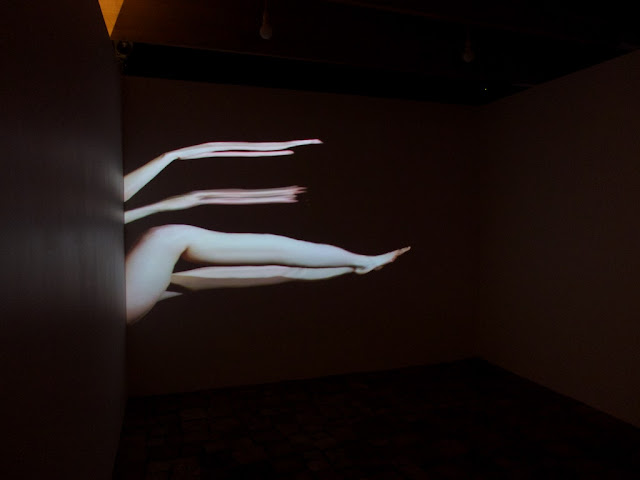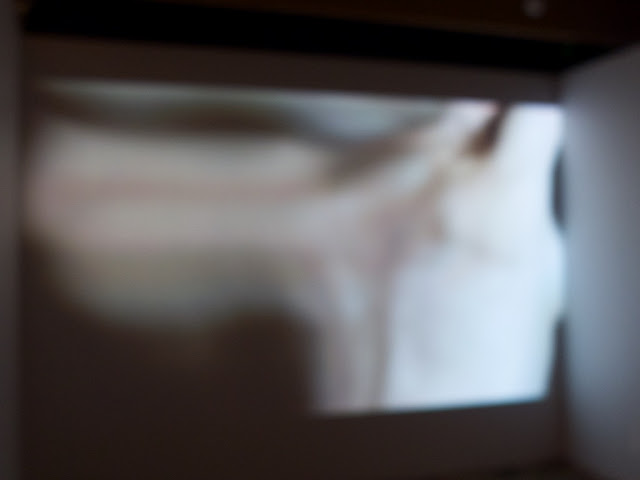Flytestein, Kaia Hugin
RAKE Visningsrom, 19 - 28 february.
Sometimes the first idea that pops into your head is the best. No need to spend time thinking any further, no need to create unnecessary problems. Just go with it! When RAKE asked me if I was interested in proposing an artist for the Collaborative Curating Project (a great idea!) my immediate response was - I want to make an exhibition with Kaia Hugin. No doubts in my mind. Happily, Kaia agreed, and even better, decided to make a new work for the exhibition. Here it is, Flytestein, a four minute, fifty second digital film, completed two days before the opening.
So why was my immediate response to invite Kaia Hugin? I have followed her work over several years, since she was a master student at Bergen Academy of Art and Design, and my admiration for her art has grown. I think she is one of the most interesting artists active in Norway today, her work is compelling and is also quite difficult.
Until very recently (this week!), all of her film/video works shared a common title, “Motholic Mobble”, a title that is a challenge in itself. It says “Don’t put me in a box”. It says “I have established my own category”. It says “This is my world”. Not that I am suggesting that Kaia’s work is cut off from the broader currents of art and visual culture, not at all. One sees echoes of 1960’s body art, the early video art of the 1970’s, the cinematic languages of directors such as David Cronenberg and David Lynch, and now, in Flytestein, direct references to the Hungarian photographer André Kertész, specifically his series “Distortions” created in 1933. More of Kertész later.
Good artists take their life experiences with them into their practice and thereby develop a language that creates a shared space with the viewer. Kaia Hugin has been a dancer, a mountain climber, a photographer and since 2009, a film/video maker, and most often, a performer in her own works. Add to this that she is a mother - her son was performer in the 2015 video Angry Boy/Happy Boy (Motholic Mobble part 10) - and now, in Flytestein, she is also a mother-to-be. Her pregnant body, reflected in distorting mirrors, is all we see in her new film. The transformation happening to her body from the inside is amplified on the outside by the effects of the concave and convex mirrors through which the images are filmed.
A striking characteristic of Kaia Hugin’s films is their production quality. For some artists this is not an issue, and there is an aesthetic attraction in low-resolution, one-shot video art. But Kaia’s work is conscious of the language of cinema and demands rigour. Her cinematographer husband Tor Willy Ingebrigtsen is an important partner in the realisation of her films, as cameraman. The use of sound in her work is also a significant factor and is treated with precision and sensitivity.
But so far I have been circling the real issue, which is, what is Kaia Hugin’s work, what are Motholic Mobbles? As I have mentioned above, the title is almost a provocation, a denial of easy categorisation. Her works combine and balance oppositions, elegantly. They are attractive, but there is also a trace of repulsion, as viewers we are drawn in, but also held at a distance. The bodies in her works are often restless, challenged, awkward, uneasy, haunted, driven by seemingly involuntary inner forces, in control and beyond control, fragmented or reconfigured. Did I mention surrealism also? It can’t be ignored. Andre Bréton once stated “Beauty shall be convulsive, or not at all”. Almost a century later, she nails it, precisely.
And so to the inspiration for Flytestein, André Kertész, a master of modernist photography. I first encountered his work in an exhibition at The Photographers Gallery, London, in the early 1970’s when I was an art student. I remember being struck by the atmosphere and the implied dramas and narratives of his images. They seemed to be more than photographs, they seemed to be more like films, condensed into a single image, a single moment. One image has always stayed with me - it is an image of a street in Paris, taken in 1928. Damaged houses on both sides of the street converge on a patch of open, rubble-strewn ground, and in the background, a massive stone viaduct over which a steam locomotive passes. In the foreground, a man in a dark coat and hat crosses the street, carrying a large package. Whole novels could be written with this image as a central narrative device. In another image, from many years later, two large birds, probably sea birds, are seen flying in front of the twin towers of the World Trade Centre, New York. With hindsight the image is unsettling, but even at the time, it must have been a haunting photograph, there is a desolate quality within it like an advance echo of what was to come.
Distortions, the direct source for Kaia Hugin’s new film, is a very different photographic series. Experimental, playful, sensuous, and perhaps it has been a reference for other artists too. I think of Carolee Schneeman’s film Meat Joy, for instance. Kaia follows the methods Kertész used for these images and introduces movement. In her movements - choreographed or improvised - she creates a sequence of new bodies, each one melting into fresh forms as the film progresses.
Flytestein is an experimental film, belonging to and building upon a tradition of artist’s cinema that has existed as long as the cinema itself. For those who are not yet familiar with the work of Kaia Hugin, I hope that this is an introduction that will draw you further into the work of one of our most challenging and engaging artists. For those who know her work already, I hope that this exhibition will meet expectations.
My thanks to Kaia, Tor Willy, Charlotte and Trygve.
Jeremy Welsh
18-02-2016.







No comments:
Post a Comment